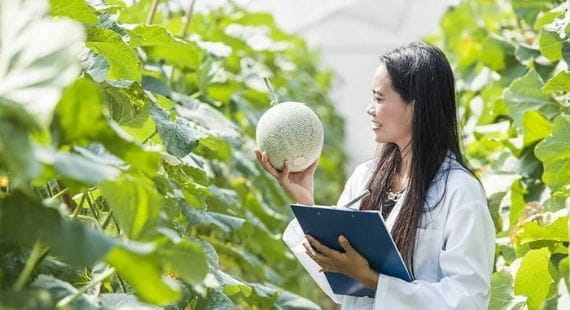
Increasing trust and transparency in the food supply chain
Increasing trust and transparency in the food supply chain
“This technology enables different parts of the food supply chain to share details in real-time, increasing trust and transparency. It eliminates information asymmetry for consumers and can potentially show a product’s journey from field to stores.”
Dr. Ron Wacker
Global Business Unit Manager of Food, Health & Beauty, TÜV SÜD
Thursday August 31, 2017
Here is a statistic bound to worry both food producers and consumers: According to the TÜV SÜD Safety Gauge Food Segment Report, only 64 percent of companies say they can trace every component of their products through the supply chain. In a time dubbed the “era of transparency,” this is disconcerting to say the least. But blockchain technology could potentially bridge this gap.
Some say change cannot come quickly enough. Product recalls are on the rise in recent years, as reported by the UK’s Food Standards Agency. Allergen labelling issues are also causing an uncomfortable recall rise in the EU, and the United States.
In an increasingly aware market, food safety problems can escalate to international incidents. Take the salmonella outbreaks in Canada and the United States, the high-profile horsemeat food fraud scandal in Europe, or the recent Fipronil contaminated eggs scandal for example. The public is perpetually on guard, and the slightest of scares can now affect producers’ reputations, often resulting in an instantaneous hit on profits.
For larger companies dealing with multiple suppliers, it can often take weeks or months to track down the source of a contamination, during which time social media storms can brew to critical mass. More importantly, the time lag to locate the source would lead to an increased scale of contamination and a resulting grave cost. This is why manufacturers are holding out hope that blockchain breakthroughs could one day help nip all potential contamination issues in the bud.
But what is blockchain? And what can it do for the food industry?
Blockchain technology is relatively complicated. But at its core, it is a system that helps do away entirely with outdated paper ledgers or centralized databases, allowing several parties to log their transactions using a cryptographically verifiable, peer-based network sharing ring. Previously, data sharing was limited to players who have direct contact. No persons had an end-to-end perspective of the information throughout the entire supply chain.
Blockchain enables this end-to-end traceability where information is shared in a single ledger, and updated through consensus. This lets players create blocks of data that are time-stamped and chained to one another. Once the blocks are fully formed, their data cannot be changed – making for an immutable digital ledger.
As powerful as it sounds, blockchain technology is still in its infancy. It began life in the Bitcoin universe, offering a means of tracing time-stamped currency interactions. However, it has quickly evolved, becoming a stand-alone technology in its own right. Its potential is much-heralded. In the worlds of manufacturing, retail and logistics, blockchain evangelists can be found everywhere.
In the food sector, too, blockchain could well become a game-changer.
In the age of the 5,000 mile salad, food products can contain multiple ingredients and packaging from all four corners of the globe. The frozen lasagna you pick up at the supermarket tonight could contain tomatoes from one continent, beef from another and milk from elsewhere. Should a contamination break out, how could the manufacturer hope to trace the source?
With its immutable blocks of data and time stamps, blockchain, arguably provides the ability to do this and more.
Dr. Ron Wacker, TÜV SÜD’s Global Business Unit Manager of Food, Health & Beauty, noted, “Blockchain can promote transparency in the supply-chain by providing permissioned, real-time visibility."
"Information stored on the blockchain can include product dates, shelf life, factory information, testing and inspection results, certifications, location and more. This is easily retrievable by any stakeholder participating in the ledger."
Dr. Ron Wacker
Global Business Unit Manager of FHB, TÜV SÜD
Retailers are now starting to look at ways to turn blockchain into a fully functioning reality.
American retailer Walmart has teamed up with IBM and China’s Tsinghua University to create a blockchain-based food monitoring system. The system is a compendium of data, including farm origination details, factory and processing data, intermediary details, storage temperatures and shipping information.
Also in China, e-commerce platform Alibaba has announced its blockchain experimentation – launching a digital ledger system not unlike a giant global spreadsheet, allowing stakeholders to track genuine food products through the supply chain. This move, says the company, will help verify authenticity, allowing the platform’s administrators to quickly earmark potential fakes.
Taiwan’s e-commerce platform, OwlTing, connects consumers directly to food producers, integrating blockchain technology into its supply chain infrastructure. And pork suppliers KMP Private are using blockchain to digitally track and trace meat products from the company’s Indonesian piggery all the way to its Singaporean consumers.
As tempting as it may seem to think of blockchain as a silver bullet, a plethora of obstacles still stand in the way of its progress.
Dr. Wacker explains, “In many cases, people simply don’t understand how this technology works. It also has a relatively high initial setup cost, which can be off-putting.
”Experts say that using blockchain requires manufacturers to take a leap of faith. “Introducing blockchain means shifting from long-held traditional ways of keeping records,” says Dr. Wacker. “It involves placing your trust in a decentralized system – and for some, that can feel like surrendering control over ledger management.
”Fortunately, blockchain does not necessarily have to involve a journey into the unknown. Although the technology is still in its early days, TÜV SÜD is now partnering with global players and getting to the forefront of defining new services.
However, with an understanding of changing local and international regulations on top of an extensive experience working with end-to-end supply chain players, TÜV SÜD can already provide many of the key tools companies need to pioneer blockchain systems.
Blockchain technology is still experimental, and its wide-scale implementation in the food industry is still very far off.
That said, it does represent a bold step in the right direction: boosting traceability, re-building consumer trust and lowering product recall risks. If blockchain can deliver, its potential in the food industry seems limitless.
Companies concerned about the costs of pilot schemes can also take heart from the Safety Gauge’s findings: The number of consumers willing to pay a safety premium for food product is on the rise, climbing from 75 percent in 2012 to 80 percent last year.
And per TÜV SÜD’s experts, the technology has the potential to let not only producers, but also their customers enter an exciting new sphere of total supply chain traceability.
“Blockchain could eliminate information asymmetry for customers,” says Dr. Wacker. “We can even envision a future where a ‘scan’ of a product’s label shows a customer its journey from the fields all the way to the store.”

Satisfy your appetite for business and consumer insights
Learn more


Site Selector
Global
Americas
Asia
Europe
Middle East and Africa